Weekly cattle and sheep market wrap
Key points
- With a good selection of cattle available, the market has remained stable.
- The heavy lambs and sheep price gap continues to widen.
- For the second consecutive week, the largest combined sheep and lamb slaughter on record was achieved.
Cattle market
The cattle market remained stable this week, while yardings eased by 13,548 to 66,733 head. Throughput at certain saleyards was subdued due to good rainfall over the past week.
The Feeder Steer Indicator increased by 5¢ to 349¢/kg liveweight (lwt), with Dalby recording the largest yarding of cattle in the country at 7,471 head. An easing in prices was experienced across eastern states, with little competition between feeders and restocker buyers.
The Heavy Steer Indicator eased by only 0.4¢ to 323¢/kg lwt. With a good selection of well-finished cattle, the price has remained stable, however, the market seemed erratic for both domestic and export buyers.
Sheep market
The sheep market continued to move in a positive direction, with the Merino Indicator experiencing the highest price increase (72¢). Sheep and lamb throughput lifted by 2,729 head. Lamb yardings rose by 9,608 and sheep yardings eased by 6,879 head.
Market reports indicate a continued decline in lamb quality. The lack of weight and finish on these lambs is contributing to a widening in the price differential between the heavier and lighter animals. The Heavy Lamb Indicator rose by 11¢ to 872¢/kg carcase weight (cwt).
The Mutton Indicator saw a 3¢ increase to 367c/kg cwt, while yardings dropped by 5,672 to total 80,224 head. The average price for mutton at Ballarat was just below 400¢/kg cwt. There continues to be a rise in mutton slaughter, caused by the widening price differential between heavy lambs and mutton.
Slaughter
Week ending 22 November 2024
Cattle slaughter eased by 528 to 145,159 head, but despite the ease, this week still marked the second largest slaughter since 2020. Slaughter remained stable in most states. However, an ease of 1,060 head was experienced in NSW, while a lift of 1,283 head was seen in Queensland.
Combined sheep and lamb slaughter lifted by 15,148 to 733,459 head. This is the second consecutive week the combined slaughter has reached the largest weekly slaughter record. Lamb slaughter lifted by 3,722 to 480,802 head. Slaughter remained steady in most states, however NSW slaughter rose by 5,828 head. Sheep slaughter was the largest in over two decades at 252,657 head. A total increase of 11,426 head was due to lifts in NSW (9,708), Tasmania (1,385) and Western Australia (5,119).
Attribute to Emily Tan, MLA Market Information Analyst



